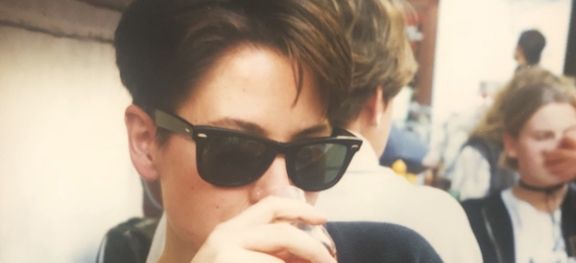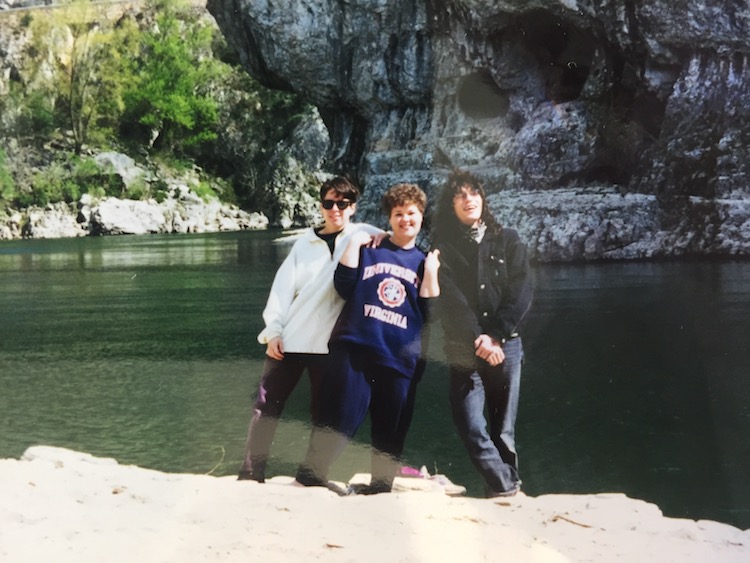Competition – Melanie Hawks


Melanie Hawks writes, 'Thank you for the opportunity to enter this competition. The two photos attached represent the two different facets of the main story and were taken contemporaneously with the events described in Paris (Le Saint Séverin brasserie across from the church; I still have the receipt from 1994!) and the region of Ardéche (on the picnic beach, with a portion of the arch in the background).
'I lived in Salt Lake City, Utah in 1994, when I discovered the bottle, and still do today. I have no connection to the wine trade. I worked at a homeless shelter in 1994 and have made my way through the nonprofit/higher education world to become established as a research library administrator and occasional consultant. I started buying wine books for my library's browsing (popular reading) collection a few years ago because I remember what it was like to not know anything and not know where to start learning. I could just as well have written this essay about a CD-ROM I purchased in about 1996, Oz Clarke's Guide to Wine.' Here is her (unedited) entry in our seminal wine competition.
My high school French teacher introduced me to the passé composé and the croque monsieur. She taught me to fold, not cut, the lettuce in my salad and to make the liaison between “les” and “amis,” and to recognize the names Marianne, Verlaine, Prévert. To my 1980s Kansas teenage self, holding a library card but not a passport, French class represented France, and France represented everything my 1980s Kansas teenage self craved. Clichés, in retrospect, but what else could my untraveled, bookish girl’s dreams have been made of? France was Camembert and Port Du Salut, Le Petit Prince and La Résistance, Delacroix and Duras and Doisneau. France was a boulevard, a lover, a film. France was out there.
My imagination proved stronger than my determination. My early twenties arrived, still passport-less. I changed states, and cities, but the closest I came to France was the wine store. Desire for something, someone, more worldly, an escape from my post-college confusion of compromised ideals and material longing, drew me to this alien terrain. The bottles were laid first by country of origin, then region, then price. I knew the geography of France thanks to Madame, which is to say I knew that France was approximately the size of Texas and I could find the Loire on a map. But wine geography was another realm, unknown and unrelatable to my twenty-something self, subsisting on my less-than-a-bottle-of-wine-an-hour wage. I chose at almost-random, training my eye to catch the the lowest numbers at the end of each region’s range, skipping entirely the double-digit zones, pleased by the way words like “Beaujolais” and “Ventoux” felt on my tongue. Each mysterious bottle was a treasure, saved for the moment, the someone, the hoped-for transformation of an evening.
And then, my chance: I saved enough to visit my college roommate during her graduate school year abroad. She was studying French and teaching in a lycée just outside of Paris, a short ride on the RER to Place Saint-Michel. I explored the city mostly alone, learning too late not to make the liaison between “Les” and “Halles,” daring to speak my stumbling French only to order pichets de vin in the tabacs and cafés, so enchanted by saying “pichet de vin” and sitting at a tiny table facing out to the boulevard that I never thought or cared to ask what I might be drinking with my croque monsieur. I was drinking it for no reason except to be drinking it, to be immersed in the moment’s pleasure, to be the kind of woman who would drink wine alone in the middle of the afternoon on the Boulevard Saint-Michel.
We took the TGV to Lyon to visit a French friend who was eager to show us the natural landscape he called “my country” in English for my benefit. He rented a Twingo for the pilgrimage to a landmark I had become enamored of in my guidebook, the Pont d’Arc. This natural stone bridge arches across a section of the Ardèche River, lying in a canyon carved from limestone. Reaching it requires an occasionally terrifying drive along what Google Maps now tells me is the D290, a narrow, hairpin-curve road that rises to the top of the cliffs and descends to the bottom of the gorge. We listened to the radio and pretended we saw wild boars through the trees (“Attention! Sanglier!”). We stopped for photos, posing closer to the edge than we would today. Arriving at our destination, we landed on a beach and enjoyed a picnic as we watched the kayaks paddling beneath the arch.

If we had wine, I don’t remember. I do remember watching one of my friends divide a baguette into thirds, slice each portion lengthwise, and drop a generous portion of Camembert into the open center. This was not my imaginary France, out there; this France was a spontaneous sandwich on a beach, a trio singing along to the radio, an elusive animal in the trees. This was a France taking root in me.
And then, home, where everyone wanted to hear which museums and monuments I had checked off their approved list, but no one wanted to know about the silent, wine-drenched days I had passed, and no one had ever heard of Ardèche. I returned to the wine store and made my way to “France” determined to recapture the spirit of the pichet de vin—I would drink wine always, anytime, for no reason, by myself, for myself.
And then, the label. I had probably seen it before, but only recognized it now: Louis Latour, Ardèche Chardonnay.
Ardèche! Ardèche? There was wine, from Ardèche? I could have Ardèche, here with me? The spirit of the Pont d’Arc?
The bottle was the first I ever purchased intentionally, wanting that particular wine, from that particular place. It became a house staple that saw me through those single-digit, end-of-range years, a choice I could confidently make from a restaurant’s list when most of the choices were still baffling, a time machine to an earlier me, a France I could pour into a glass.
I understand now why this wine had such power over me—it gave me such power.
The Vernaccia di San Gimignano that reminds me of a rainy day in Tuscany, the Spanish rosado that I know to pour for a friend without asking, the Burgundy and Condrieu I’m dreaming of as I plan my upcoming trip to the regions my eye once skipped over. Wine takes me out there, bridging the past and the present, the known and the unknown, the real and the imagined, connecting me to the people and places I love.
Become a member to view this article and thousands more!
- 15,396 featured articles
- 274,621 wine reviews
- Maps from The World Atlas of Wine, 8th edition (RRP £50)
- The Oxford Companion to Wine, 5th edition (RRP £50)
- Members’ forum
- 15,396 featured articles
- 274,621 wine reviews
- Maps from The World Atlas of Wine, 8th edition (RRP £50)
- The Oxford Companion to Wine, 5th edition (RRP £50)
- Members’ forum
- Commercial use of our Tasting Notes